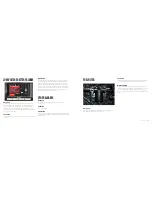
2017 OWNERS MANUAL /
410
Check the tow vehicle owner’s manual prior to first time use.
The importance of sufficient weight load on the trailer tongue (cre-
ating downward force on the hitch ball) cannot be over-stated.
The Trailer Hitch
There are two basic types of trailer hitches: a weight-carrying hitch
and a weight-distribution hitch. A weight-carrying hitch is rec-
ommended for use with a MasterCraft boat and trailer. However,
weight-distributing (equalizing) hitches may be used.
If using a weight-distributing hitch, the chain must be vertical
(straight up and down) under the pulling load where the actuator is
extended. Excessive tongue weight beyond the actuator rating must
be avoided as it will reduce the brake performance and could dam-
age the actuator. Always follow the hitch manufacturer’s instruc-
tions. Before deciding which type of hitch to use, consult the tow
vehicle manufacturer for recommendations from the tow vehicle’s
perspective.
Be sure that the total weight of the trailer-boat rig does not exceed
the hitch’s load capacity. The maximum permissible weight for the
hitch should be stamped on the hitch. The hitch should also provide
a place for attaching the trailer’s safety cables—two rings or holes
on either side of the hitch ball. Be sure the hitch ball is the correct
size to match the coupler on the trailer. The correct ball diameter is
marked on the trailer coupler.
Failure to use a two-inch (2”) hitch ball and mount rated to 8500-
lbs. or higher, where required, may result in failure of the hitch on
the tow vehicle and a loss of control of the trailer while towing,
which may cause serious injury or death.
A truck or van using a step bumper as the hitch platform will need to
have safety cable attachments such as eye-bolts, as well as a hitch
ball, which has been installed according to the Society of Automo-
tive Engineers (SAE) J684 Standard. Installing a light or heavy-duty
hitch can be a major undertaking. The hitch and its installation must
meet the SAE J684 Standard. It is recommended that the job be
done by a professional. An authorized MasterCraft dealer can offer
advice.
Loose objects may damage the boat and/or trailer. Such damage is
not covered by the warranty.
Weight Distribution
Improper weight distribution within the boat can cause instability
and loss of control while towing, which may result in death, serious
injury or property damage.
Improper weight distribution can cause a boat trailer to fishtail
(sway from side to side) as it moves down the highway, putting
excessive strains on both the trailer and the tow vehicle, which
increases gas consumption and may cause an accident. The most
effective way to guard against fishtailing is to make sure the weight
load on the trailer is properly distributed.
It is extremely important that a minimum of five percent (5%) and
a maximum of ten percent (10%) of the total weight on the trailer is
on the trailer coupling ball when the tongue is parallel to the ground.
A bathroom scale can be used for this determination. For example,
if the gross weight of the trailer, boat and gear is 3,000 pounds, the
weight on the tongue should not be more than 300 pounds, but not
less than 150.
To ensure that the boat is riding properly on the trailer supports, the
trailer should be in a level position when hitched to the tow vehicle.
With the trailer hooked up to the tow vehicle and the jack stowed,
measure from the bottom of the frame (behind the swing tongue)
to the ground. This measurement should be 20.5”-21.5,” failure to
adjust to this height may prematurely activate the surge brakes.
This can be corrected in a number of different ways. For example, air
pressure adjustable shock absorbers may be installed on the tow
vehicle, or you can switch from a weight-carrying to a weight-distrib-
uting hitch. Consult with the tow vehicle’s dealer or manufacturer.
If the total weight on the loaded trailer exceeds the load capacity of
the hitch on the tow vehicle, the trailer may break free, which may
result in serious injury or death and/or property damage.
Never Attach The Trailer To Any Device Between The
Trailer And The Tow Vehicle
The photo shows an example of an improper
device attached between a trailer and tow
vehicle that may create a dangerous condition
for towing a boat. Devices like the one shown
in the photo
Summary of Contents for NXT20 2017
Page 3: ...2017 OWNERS MANUAL SAFETY KNOWLEDGE ...
Page 27: ...2017 OWNERS MANUAL 48 2017MODEL FEATURESANDSPECS ...
Page 40: ...2017 OWNERS MANUAL 74 DASHESAND VIDEOSCREENS ...
Page 42: ...2017 OWNERS MANUAL 78 XANDXTSERIESINSTRUMENTPANEL 4 3 VIDEOSCREEN XSTARINSTRUMENTPANEL ...
Page 43: ...2017 OWNERS MANUAL 80 PROSTARINSTRUMENTPANEL NXTSERIESINSTRUMENTPANEL ...
Page 58: ...2017 OWNERS MANUAL 110 XANDXTSERIES VIDEOSCREEN OPERATIONSHV450 ...
Page 67: ...2017 OWNERS MANUAL 128 XSTAR VIDEOSCREEN OPERATIONS XSTARINSTRUMENTPANEL ...
Page 80: ...2017 OWNERS MANUAL 154 PROSTAR VIDEOSCREEN OPERATIONS ...
Page 97: ...2017 OWNERS MANUAL 188 NXT OPERATIONS ...
Page 101: ...2017 OWNERS MANUAL 196 NXT20 22 VIDEOSCREEN OPERATIONS ...
Page 107: ...2017 OWNERS MANUAL 208 BOAT OPERATIONS ...
Page 158: ...2017 OWNERS MANUAL 310 PREPARATION ...
Page 172: ...2017 OWNERS MANUAL 338 CAREAND MAINTENANCE ...
Page 204: ...2017 OWNERS MANUAL 402 TRAILERS ...
















































